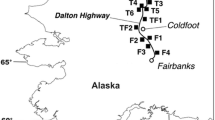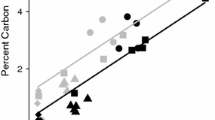Abstract
Aims
Vegetation stimulates, in general, soil mineral weathering. It has been hypothesized that plant-associated microorganisms, especially ectomycorrhizal fungi play a major role in this process. We studied apatite dissolution in a vegetation gradient in southern Norway to test the role of ectomycorrhizal vegetation on mineral weathering.
Methods
A natural occurring lead contamination, probably present since the last glaciation, caused a gradient from bare soil, via sparse grass to healthy spruce forest. We measured apatite content, soil solution chemistry, δ 13C, δ 15N, C, N and ergosterol content in soil profiles along the gradient.
Results
The apatite loss for each soil depth could be described by the same proton-based, dissolution function over the whole vegetation gradient. The deviation from the 30–40 cm depth pH model showed, in the top 20 cm, a negative correlation with ergosterol, and a positive correlation with δ 13C. These correlations could reflect an inhibiting effect of biotic activity through the production of large weight organic acids and degradation of low molecular weight organic acids.
Conclusions
Vegetation accelerates apatite dissolution by acidifying the soil solution, but soil fungi appeared to have a retarding, rather than an enhancing effect on this process.







Similar content being viewed by others
References
Bååth E, Díaz-Raviña M, Bakken L (2005) Microbial biomass, community structure and metal tolerance of a naturally Pb-enriched forest soil. Microb Ecol 50:496–505
Bockheim JG (1980) Solution and use of chronofunctions in studying soil development. Geoderma 24:71–85
Boström B, Comstedt D, Ekblad A (2007) Isotope fractionation and 13C enrichment in soil profiles during the decomposition of soil organic matter. Oecologia 153:89–98
Bahr A, Ellström M, Akselsson C, Ekblad A, Mikusinska A, Wallander H (2013) Growth of ectomycorrhizal fungal mycelium along a Norway spruce forest nitrogen deposition gradient and its effect on nitrogen leakage. Soil Biol Biochem 59:38–48
Balesdent J, Mariotti A, Boutton TW, Yamasaki SI (1996) Measurement of soil organic matter turnover using 13C natural abundance. In: A Boutton and SI Yamasaki (eds):Mass spectrometry of soils. Marcel Dekker, New York, pp: 83–111
Balogh-Brunstad Z, Kent Keller C, Thomas Dickinson J, Stevens F, Li CY, Bormann BT (2008) Biotite weathering and nutrient uptake by ectomycorrhizal fungus, Suillus tomentosus, in liquid-culture experiments. Geochim Cosmochim Acta 72:2601–2618
Barrett LR (2001) A strand plain soil development sequence in Northern Michigan, USA. Catena 44: 163–86
Bonneville S, Smits MM, Brown A, Harrington J, Leake JR, Brydson R, Benning LG (2009) Plant-driven fungal weathering: early stages of mineral alteration at the nanometer scale. Geology 37:615–618
Callahan J (1987) A nontoxic heavy liquid and inexpensive filters for separation of mineral grains. J Sediment Res 57:765–766
Chaïrat C, Schott J, Oelkers EH, Lartigue JE, Harouiya N (2007) Kinetics and mechanism of natural fluorapatite dissolution at 25° C and pH from 3 to 12. Geochim Cosmochim Acta 71:5901–5912
Drever JI, Stillings LL (1997) The role of organic acids in mineral weathering. Colloids Surf A Physicochem Eng Asp 120:167–181
Ehleringer JR, Buchmann N, Flanagan LB (2000) Carbon isotope ratios in belowground carbon cycle processes. Ecol Appl 10:412–422
Finlay R, Wallander H, Smits MM, Holmström S, van Hees PAW, Lian B, Rosling A (2009) The role of fungi in biogenic weathering in boreal forest soils. Fungal Biol Rev 23:101–106
Guidry MW, Mackenzie FT (2003) Experimental study of igneous and sedimentary apatite dissolution: control of pH, distance from equilibrium, and temperature on dissolution rates. Geochim Cosmochim Acta 67:2949–2963
Hagerberg D, Thelin G, Wallander H (2003) The production of ectomycorrhizal mycelium in forests: relation between forest nutrient status and local mineral sources. Plant Soil 252:279–290
Hobbie EA, Macko ASA, Williams M (2000) Correlations between foliar δ15N and nitrogen concentrations may indicate plant-mycorrhizal interactions. Oecologia 122:273–283
Hobbie EA, Ouimette AP (2009) Controls of nitrogen isotope patterns in soil profiles. Biogeochemistry 95:355–371
Hoffland E, Kuyper TW, Wallander H, Plassard C, Gorbushina AA, Haselwandter K, Holmström S, Landeweert R, Lundström US, Rosling A, Sen R, Smits MM, Van Hees PAW, Van Breemen N (2004) The role of fungi in weathering. Front Ecol 2:258–264
Högberg P, Högbom L, Schinkel H, Högberg M, Johannisson C, Wallmark H (1996) 15N abundance of surface soils, roots and mycorrhizas in profiles of European forest soils. Oecologia 108:207–214
Jongmans AG, Van Breemen N, Lundström US, Van Hees PAW, Finlay RD, Srinivasan M, Unestam T, Giesler R, Melkerud PA, Olsson M (1997) Rock-eating fungi. Nature 389:682–683
Kalbitz K, Geyer S, Geyer W (2000) A comparative characterization of dissolved organic matter by means of original aqueous samples and isolated humic substances. Chemosphere 40:1305–1312
Kalbitz K, Kaiser K, Bargholz J, Dardenne P (2006) Lignin degradation controls the production of dissolved organic matter in decomposing foliar litter. Eur J Soil Sci 57:504–516
Koele N, Dickie IA, Blum JD, Gleason JD, de Graaf L (2014) Ecological significance of mineral weathering in ectomycorrhizal and arbuscular mycorrhizal ecosystems from a field-based comparison. Soil Biol Biochem 69:63–70
Landeweert R, Hoffland E, Finlay RD, Kuyper TW, Van Breemen N (2001) Linking plants to rocks: ectomycorrhizal fungi mobilize nutrients from minerals. Trends Ecol Evol 16:248–254
Låg J, Hvatum O, Bølviken B (1969) An occurrence of naturally lead-poisoned soil at Kastad near Gjøvik, Norway. Nor Geol Unders 266:141–159
Lichter J (1998) Rates of weathering and chemical depletion in soils across a chronosequence of Lake Michigan sand dunes. Geoderma 85:255–282
Lundström U, Øhman LO (1990) Dissolution of feldspars in the presence of natural, organic solutes. J Soil Sci 41:359–369
Mangerud J, Gyllencreutz R, Lohne Ø, Svendsen JI (2011) Glacial history of Norway. In: Ehlers J, Gibbard PL, Hughes PD (eds) Developments in quaternary sciences. Elsevier, Amsterdam, pp 279–298
Marschner H (1995) Mineral nutrition of higher plants, 2nd edn. Academic, London
Moulton KL, West J, Berner RA (2000) Solute flux and mineral mass balance approaches to the quantification of plant effects on silicate weathering. Am J Sci 300:539
Nezat CA, Blum JD, Klaue A, Johnson CE, Siccama TG (2004) Influence of landscape position and vegetation on long-term weathering rates at the Hubbard Brook Experimental Forest, New Hampshire, USA. Geochim Cosmochim Acta 68:3065–3078
Nezat CA, Blum JD, Yanai RD, Hamburg SP (2007) A sequential extraction to determine the distribution of apatite in granitoid soil mineral pools with application to weathering at the Hubbard Brook Experimental Forest, NH, USA. Appl Geochem 22:2406–2421
Nilsson LO, Wallander H (2003) Production of external mycelium by ectomycorrhizal fungi in a Norway spruce forest was reduced in response to nitrogen fertilization. New Phytol 158:409–416
Nykvist N (1963) Leaching and decomposition of water-soluble organic substances from different types of leaf and needle litter. Studia Forestalia Suecica 3:3–29
Ochs M (1996) Influence of humified and non-humified natural organic compounds on mineral dissolution. Chem Geol 132:119–124
Orwin KH, Kirschbaum MU, St John MG, Dickie IA (2011) Organic nutrient uptake by mycorrhizal fungi enhances ecosystem carbon storage: a model based assessment. Ecol Lett 14:493–502
Rogers JR, Bennett PC, Choi WJ (1998) Feldspars as a source of nutrients for microorganisms. Am Mineral 83:1532–1540
Saccone L, Gazzè SA, Duran AL, Leake JR, Banwart SA, Ragnarsdóttir KV, Smits MM, McMaster TJ (2012) High resolution characterization of ectomycorrhizal fungal-mineral interactions in axenic microcosm experiments. Biogeochemistry 111:411–425
Schabenberger O, Pierce FJ (2002) Contemporary statistical models. CRC Press, Boca Raton
Schlesinger WH (1991) Biogeochemistry. Elsevier, Amsterdam
Schott J, Pokrovsky OS, Oelkers EH (2009) The link between mineral dissolution/precipitation kinetics and solution chemistry. Rev Mineral Geochem 70:207–258
Smith SE, Read DJ (2008) Mycorrhizal symbiosis. Academic, San Diego
Smits MM (2009) Scale matters? Exploring the effect of scale on fungal-mineral interactions. Fungal Biol Rev 23:132–137
Smits MM, Bonneville S, Haward S, Leake JR (2008) Ectomycorrhizal weathering, a matter of scale? Mineral Mag 72:135–138
Smits MM, Bonneville S, Benning LG, Banwart SA, Leake JR (2012) Plant-driven weathering of apatite – the role of an ectomycorrhizal fungus. Geobiology 10:445–456
Smits MM, Hoffland E, Jongmans AG, van Breemen N (2005) Contribution of mineral tunneling to total feldspar weathering. Geoderma 125:59–69
Sverdrup H, Hagen-Thorn A, Holmqvist J, Wallman P, Warfvinge P, Walse C, Alveteg M (2002) Biogeochemical processes and mechanisms. In: Sverdrup H, Stjernquist I (eds) Developing principles and models for sustainable forestry in Sweden, managing forest ecosystems. Kluwer Academic Publishers, Dordrecht, pp 91–196
Sverdrup H (2009) Chemical weathering of soil minerals and the role of biological processes. Fungal Biol Rev 23:94–100
Taylor LL, Leake JR, Quirk J, Hardy K, Banwart SA, Beerling DJ (2009) Biological weathering and the long term carbon cycle: integrating mycorrhizal evolution and function into the current paradigm. Geobiology 7:171–191
Van Hees PAW, Lundström US, Giesler R (2000) Low molecular weight organic acids and their Al-complexes in soil solution - composition, distribution and seasonal variation in three podzolized soils. Geoderma 94:173–200
Van Schöll L, Smits MM, Hoffland E (2006) Ectomycorrhizal weathering of the soil minerals muscovite and hornblende. New Phytol 171:805–814
Wallander H (2000) Uptake of P from apatite by Pinus sylvestris seedlings colonised by different ectomycorrhizal fungi. Plant Soil 218:249–256
Wallander H, Thelin G (2008) The stimulating effect of apatite on ectomycorrhizal growth diminishes after PK fertilization. Soil Biol Biochem 40:2517–2522
Welch SA, Ullman WJ (1993) The effect of organic acids on plagioclase dissolution rates and stoichiometry. Geochim Cosmochim Acta 57:2725–2736
Welch SA, Taunton AE, Banfield JF (2002) Effect of microorganisms and microbial metabolites on apatite dissolution. Geomicrobiol J 19:343–367
Acknowledgments
Funding was provided by the Swedish Energy Agency (STEM), the Swedish Research Council and the Flemish Research Foundation (FWO). We like to thank Tommy Olsson, from Lund University, for technical support with the ICP-AES. We gratefully acknowledge the useful comments of two anonymous reviewers and the section editor (Thomas Kuyper).
Author information
Authors and Affiliations
Corresponding author
Additional information
Responsible Editor: Thom W. Kuyper..
Electronic supplementary material
Below is the link to the electronic supplementary material.
Table S1
Soil solution element composition obtained from fresh soil samples by centrifugation (s.e. based on the three replicated soil pits in italics). (DOCX 23 kb)
Fig. S1
Sr versus Ca in the apatite extraction step in unground (‘Free apatite’) and ground (‘occluded apatite’) soil samples. (GIF 28 kb)
Fig. S2
Ca versus P in the apatite extraction step in the unground soil samples. The dashed line denotes the theoretical ratio in fluorapatite (Ca5(PO4)3F). (GIF 30 kb)
Rights and permissions
About this article
Cite this article
Smits, M.M., Johansson, L. & Wallander, H. Soil fungi appear to have a retarding rather than a stimulating role on soil apatite weathering. Plant Soil 385, 217–228 (2014). https://doi.org/10.1007/s11104-014-2222-6
Received:
Accepted:
Published:
Issue Date:
DOI: https://doi.org/10.1007/s11104-014-2222-6




